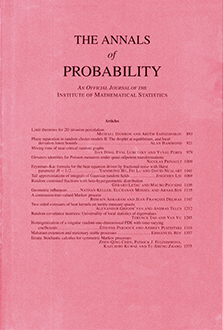Abstract
We study the zero temperature limit for interacting Brownian particles in one dimension with a pairwise potential which is of finite range and attains a unique minimum when the distance of two particles becomes a>0. We say a chain is formed when the particles are arranged in an “almost equal” distance a. If a chain is formed at time 0, so is for positive time as the temperature of the system decreases to 0 and, under a suitable macroscopic space-time scaling, the center of mass of the chain performs the Brownian motion with the speed inversely proportional to the total mass. If there are two chains, they independently move until the time when they meet. Then, they immediately coalesce and continue the evolution as a single chain. This can be extended for finitely many chains.
Citation
Tadahisa Funaki. "Zero temperature limit for interacting Brownian particles. II. Coagulation in one dimension." Ann. Probab. 32 (2) 1228 - 1246, April 2004. https://doi.org/10.1214/009117904000000199
Information





